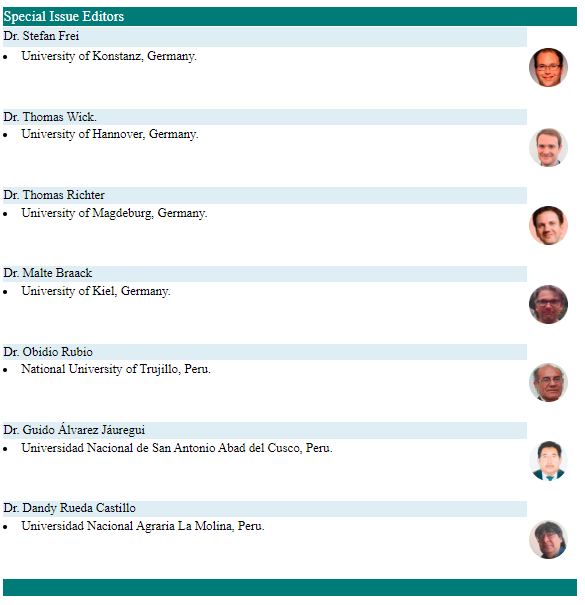Applications of the duality theory of convex analysis to the complete electrode model of electrical impedance tomography
DOI:
https://doi.org/10.17268/sel.mat.2023.01.09Palavras-chave:
Electrical impedance tomography, duality theory, complete electrode model, direct problemResumo
The duality theory of convex analysis is applied to the complete electrode model (CEM), which is a standard model in electrical impedance tomography (EIT). This results in a dual formulation of the CEM and a general error estimate. This new formulation of the CEM is written in terms of current fields and is shown to have a unique solution. Using this formulation, the general error estimate is proved, from which two a posteriori error estimates and a well known asymptotic result on CEM solutions are obtained. The first a posteriori error estimate assesses the accuracy of solutions to approximate problems, and the second one assesses the accuracy of approximate solutions. Numerical tests to apply this second estimate are performed, employing the finite element method to obtain approximate solutions.
Referências
Calderón AP. On an inverse boundary value problem. “Seminar on Numerical Analysis and its Application to Continuum Physics” in the ATAS of SBM. 1980; 65-73.
Adler A, Holder D. Electrical Impedance Tomography: Methods, History and Applications. Boca Raton: CRC Press; 2021.
Cheney M, Issacson D, Newell JC. Electrical Impedance Tomography. SIAM Rev. 1999; 41(1):85-101.
Cheng K, Isaacson D, Newell JC, Gisser DG. Electrode models for electric current computed tomography. IEEE Trans Biomed Eng. 1989; 36(9):918-924.
Somersalo E, Cheney M, Isaacson D. Existence and uniqueness for electrode models for electric current computed tomography. SIAM J Appl Math. 1992; 52(4):1023-1040.
Hadamard J. Le probléme de Cauchy et les équations aux dérivées partielles linéaires hyperboliques. Paris. 1932; 11:243-264.
Ekeland I, Teman R. Convex Analysis and Variational Problems. SIAM; 1999.
Repin S, Sauter S, Smolianski A. A posteriori error estimation for the Dirichlet problem with account of the error in the approximation of boundary conditions. Computing. 2003; 70(3):205-233.
Repin S, Sauter S, Smolianski A. A posteriori error estimation for the Poisson equation with mixed Dirichlet/Neumann boundary conditions. J Comput Appl Math. 2004; 164/165:601-612.
Han W. A posteriori error analysis for linearization of nonlinear elliptic problems and their discretizations. Math Meth Appl Sci. 1994; 17(7):487-508.
Han W. A posteriori error analysis via duality theory: with applications in modeling and numerical approximations. New York, NY: Springer; 2005.
Dardé J, Staboulis S. Electrode modelling: The effect of contact impedance. ESAIM: M2AN. 2016; 50(2):415-431.
Ma E. Integral formulation of the complete electrode model of electrical impedance tomography. IPI. 2020; 14(2):385-398.
Attouch H, Buttazzo G, Michaille G. Variational Analysis in Sobolev and BV Spaces: applications to PDEs and optimization. 2nd ed. Philadelphia, PA: SIAM; 2014.
Schuster T, Kaltenbacher B, Hofmann B, Kazimierski K. Regularization Methods in Banach Spaces. Berlin, Boston: De Gruyter; 2012.
Jin B, Xu Y, Zou J. A convergent adaptive finite element method for electrical impedance tomography. IMA J Num Anal. 2017; 37(3):1520-1550.
Downloads
Publicado
Como Citar
Edição
Seção
Licença

Este trabalho está licenciado sob uma licença Creative Commons Attribution 4.0 International License.
Os autores que publicam nesta revista aceitam as seguintes condições:
Os autores mantêm os direitos autorais e atribuem à revista o direito da primeira publicação, com o trabalho registrado com a licença de atribuição Creative Commons Atribución 4.0 Internacional (CC BY 4.0), que permite que terceiros usem o material publicado sempre que mencionarem a autoria do trabalho e os direitos autorais. Primeira publicação nesta revista.
Os autores podem fazer outros acordos contratuais independentes e adicionais para a distribuição não exclusiva da versão do artigo publicada nesta revista (por exemplo, incluí-la em um repositório institucional ou publicá-la em um livro), desde que afirme claramente que o trabalho Foi publicado nesta revista.
É permitido e recomendado aos autores que publiquem seus trabalhos na Internet (por exemplo, em páginas institucionais ou pessoais) antes e durante o processo de revisão e publicação, pois isso pode levar a trocas produtivas e a uma disseminação maior e mais rápida do trabalho. publicado (Consultar: efeito do acesso aberto).












